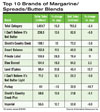
There appear to be two primary forces at work in the flat butter market: perception of wellness and the economy.
Overall butter sales approached $1.3 billion for the 52 weeks ending Aug. 9, up 0.77% over the previous year, according to Chicago-based Information Resources Inc. Of that total, private label butter accounted for nearly $665 million, a 7.4% increase, while the top brand name, Land O’Lakes, saw its dollar sales drop the same percentage to $329.7 million.
In fact, all brands in the top 10 except two saw their dollar sales drop, according to IRI data. Unit sales followed a similar pattern, with an overall increase of nearly 3%.

“Health trends challenge market even as rising dairy costs create sales spikes,” says the most recent executive summary on the butter and spreads market from Chicago-based Mintel. “The $5.2 billion market for butter, margarine and table spreads in the U.S. has been challenged by the trend toward healthier eating for the past several years. Americans are cutting down on fats overall, and are also substituting fats perceived to be healthier like olive oil for butter and margarine.”
But Mark Korsmeyer, president of Dairy Food Products at Kansas City, Mo.-based Dairy Farmers of America, views the current market a bit differently. “In the current economy, more families are eating at home and utilizing butter at home, which has helped the butter category,” says Korsmeyer, citing data indicating butter sales are up about 4% while non-butter spreads are down about as much. “More families cooking at home increases the opportunity to try different types of butter such as European-style, spreadable or whipped.”

Amy Levine, director of marketing at Vermont’s Cabot Creamery, sees a similar picture. “We see more cooking at home and more comfort foods in times of economic stress. This category benefits from that,” Levine says. Cabot was the only other butter brand in the top 10 to grow sales this past year, by almost 8%, according to IRI data.
“We find that consumers are looking for good quality and that has them looking for Cabot,” Levine says. “Consumers are also looking for a meaningful purchase, and 100% of our profits being returned to our farmer owners gives them that.”
The health issue, though, is a double-edged sword. “With the recent concerns about trans fats, butter as an all-natural product becomes a preferred ingredient,” Korsmeyer says.
Many spreads made with olive oil instead of vegetable oil have been launched recently, but Mintel notes consumers often lack knowledge of differences in olive oil. Consumers will likely purchase the cheapest product, unless manufacturers provide education and marketing support to convince them otherwise, Mintel suggests.
Mintel reports that more than a third of respondents to its survey have switched from margarine and spreads to butter in the past few years. “This is contrary to the advice of health organizations to use margarine as a substitute for butter as part of a healthier, lower-fat diet,” the Mintel report says.
Up until recently, butter was the trans fat-free alternative to most margarines, but many non-butter spreads have since been reformulated to remove trans fats. Others, like Smart Balance – with sales up more than 11% – are engineered to help keep cholesterol in check and promote cardiovascular health, and deliver other beneficial additives like omega-3s and flax oil.

“Specialty butter sales, such as our Pasture Butter, are driving growth in this category, even at a time with record low commodity butter prices,” says Eric Newman, vice president of sales for the La Farge, Wis.-based CROPP Cooperative, which makes Organic Valley branded products. “Our Pasture Butter is exclusively made during pasture season, cultured using Swiss cultures and is high in butter oil content (84%).”
DFA has launched Breakstone’s organic whipped butter, and fellow top 10 brand Challenge butter (made by Golden State co-op California Dairies) has gone “rBST-free.”
But Mintel notes that “hormone-free,” non-organic products are cheaper than organic products and are likely to appeal to a wider audience like those served by mass retailers helping drive the trend, like Kroger and Wal-Mart.

The road ahead
So what’s around the bend for butter and spreads?“The greatest opportunities for growth in the butter category are in new products that the consumer finds useful when cooking. Spreadable butters and flavored butters will appeal to consumers who look for new uses for butter,” Korsmeyer says. “Driving innovation through new products that will drive sales in the category is a must to support continued growth in the butter category.”
Getting those new products out there will take work, however. “We must align with retailers on programs that help grow butter products and the category as a whole,” Korsmeyer says. “Today, retailers carry both branded and store brand products, which our portfolio of butter products supports.”
Cabot’s Levine adds: “Some retailers have been limiting their butter brands in accords with SKU optimization efforts. Our brand helps to make butter more of a destination category, bringing brand and quality recognition over from other categories.”
Overall, the outlook for the category is positive, Korsmeyer says: “Butter sales are up. With the introduction of light butter, flavored butter, lower-moisture European-style butter, organic butter and holiday sculptures, the choices for consumers has grown and new users will find that butter is a great all-natural option.”
Fast Facts
Source: Mintel
Links
- State of the Industry 2009: Beverages -- Fusion of Flavors
- State of the Industry 2009: Cheese -- Spices and Slices
- State of the Industry 2009: Ice Cream--Chilling Effect?
- State of the Industry 2009: Ingredients--Ingredients With Purpose
- State of the Industry 2009: Milk--Flowing Downhill
- State of the Industry 2009: Yogurt -- It's Alive
- State of the Industry 2009: Introduction
- State of the Industry 2009: As the World Turns (Global Report)